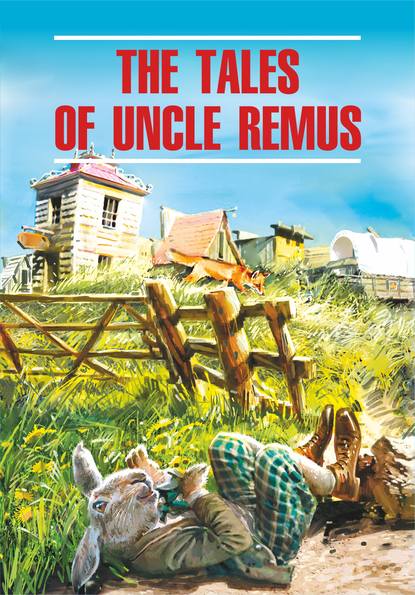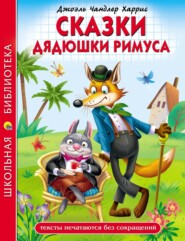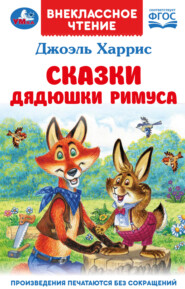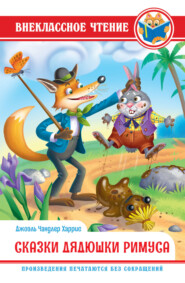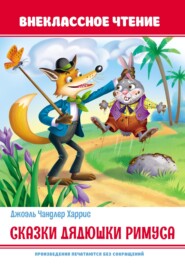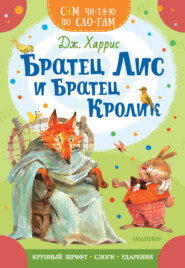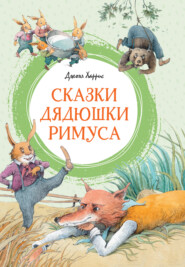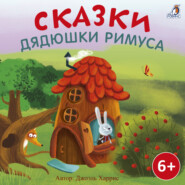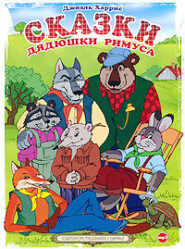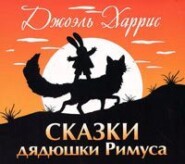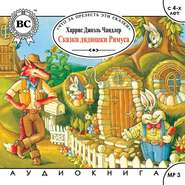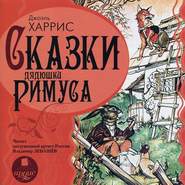По всем вопросам обращайтесь на: info@litportal.ru
(©) 2003-2024.
✖
The Tales of Uncle Remus / Сказки дядюшки Римуса. Книга для чтения на английском языке
Настройки чтения
Размер шрифта
Высота строк
Поля
The Tales of Uncle Remus / Сказки дядюшки Римуса. Книга для чтения на английском языке
Джоэль Чендлер Харрис
Е. Г. Тигонен
Чтение в оригинале (Каро)Classical literature (Каро)
«Сказки дядюшки Римуса» – собирательное название ряда сказок американского писателя Джоэля Харриса, основанных на негритянском фольклоре, объединенных рассказчиком дядюшкой Римусом. Истории, в основном собранные непосредственно из афро-американского фольклора, были революционными в использовании диалектов, персонажей животных и описании пейзажей.
В предлагаемой вниманию читателей книге приводится текст в обработке Джулиуса Лестера, который сделал его более понятным современному читателю.
The Tales of Uncle Remus / Сказки дядюшки Римуса. Книга для чтения на английском языке
© КАРО, 2014
Introduction
My lasting memories of my grandmother are of her telling me stories. I know that she told folktales and fairy tales from many parts of the world. I cried when she told Andersen’s Little Match Girl – it was so beautiful and so sad. But my favorites, and I’m sure they were hers as well, were the Brer Rabbit stories. I howled with laughter when Brer Rabbit asked the Tar Baby “and how does your symptoms segashuate?” My grandmother did not attempt to use the dialect of Joel Chandler Harris because, even though she had been born on a Maryland plantation in 1862, she did not speak the way Harris interpreted slave speech. Her mother had told her the stories and she told them to me with love and affection as she sat in her favorite rocking chair in the middle of a large, old-fashioned kitchen. It was a way for her to entertain me as she watched her cooking.
In 1917 when I was old enough to go to school I still wanted to hear about Brer Rabbit and Miz Meadows and the gals, so I would rush home to be there by “pot-watching” time. “Grandma,” I’d ask, “tell about how Brer Rabbit tricked Brer Fox.” We would get comfortable[1 - would get comfortable – (разг.) устраивались поудобнее] and start down Brer Rabbit’s road. Small, helpless Brer Rabbit always defeated his adversaries – the large animals – with his wit, humor, and wisdom. In my smallness I related to the clever little hare who could always get out of the most difficult situations through his sharp wit.
I soon wanted to read these stories myself, which led me to the only collections available, by Joel Chandler Harris. They were in a dialect that was like a foreign language and I could not handle it[2 - could not handle it – (разг.) не мог справиться]. I was frustrated and, although I loved the stories, I was too impatient to struggle with the words. Grandmother died and the Brer Rabbit stories were put into the storage of my mind.
It wasn’t until several years later, in college, that I learned about the importance of these stories as true American folklore. Dr. Harold Thompson, a leading American folklorist, gave a lecture on people from the West Coast of Africa who had been captured and sold as slaves. Some were settled in the southern states where they took stories from home about a hare – Wakaima – and adapted them to their new surroundings. Wakaima became Brer Rabbit and the clay man became the Tar Baby. Learning about this made me turn to the books again, and once again I tried unsuccessfully to read them.
In 1937 I found myself in the 135th Street branch of the New York Public Library located in the heart of Harlem as a children’s librarian. One of the prerequisites of this position was to tell stories. I soon learned that these black boys and girls needed to be introduced to the humor and hidden philosophies of Brer Rabbit and his cohorts. Here was a contribution to their racial pride – to know that their black forefathers had first told these stories and, in so doing, had added to the body of American folklore. Many of them were sensitive to the slave setting that showed Uncle Remus telling the stories to the little white boy, so I eliminated that frame. It became obvious that the tales stood on their own as their African counterparts about Wakaima did.
One day a young, dynamic woman came to the children’s room and told me that she was a student in Lucy Sprague Mitchell’s Bank Street writing course. She had decided that her project would be to retell the Uncle Remus stories. Her name was Margaret Wise Brown, who later became an outstanding author of books for the very young. She too realized that the stories could be removed from their slave setting without losing any of their unique qualities. So she eliminated the figure of Uncle Remus and titled her project simply “Brer Rabbit” and subsequently had it published under the same title. But she retained the phrasing and speech patterns of Joel Chandler Harris because she did not have the rhythm and natural speech patterns of the southern blacks. A true translation and interpretation would come from within the black experience.
Despite the drawbacks in Harris’s text, I still loved the stories and appreciated Brer Rabbit as a cultural hero and a significant part of my heritage. However, I was telling the stories less and less often because of the dialect. Then in the late forties and early fifties the Harlem schools along with others with liberal philosophies in New York City were asking that their classes be given lectures on black history[3 - on black history – (разг.) по истории черного населения]. How could I represent our African background and the relationship between Africa and black America to primary grades? How could I show the fusion of the different African cultures and the cultures existing in America and the West Indies?
The answer came one day as I was planning a story hour. I would tell Wakaima and the Clay Man, discuss in simple terms the middle passage (the slaves’ experiences on slave ships), relate Wakaima to Brer Rabbit, and finally tell Brer Rabbit and the Tar Baby. Once again I would be telling the animal stories without a truly satisfactory book for the children. As a librarian and one who feels that storytelling is an ideal way to bring together children and books, my frustration grew.
In 1972 a book was placed on my desk and I knew immediately that I had found the answer to years of seeking. Julius Lester had written The Knee-High Man and Other Tales, published by Dial. Here were black folktales told perfectly. Lester had used the voice and the language of black people. And he does so again in his tellings of the Uncle Remus stories. In the foreword to this book he calls it “a modified contemporary southern black English, a combination of standard English and black English where sound is as important as meaning.” He has preserved the story lines, the wit, the humor – all of the attributes which have made the stories so much a part of my life – while making them accessible to readers. It is interesting to read the foreword to this collection, preferably before reading the stories. Much research and personal feeling have been distilled into a concise, historical, and chronological explanation of the Uncle Remus stories. This foreword is invaluable to the appreciation of the tales.
I can not emphasize enough the importance of telling the stories. As you listen to yourself the rhythm and melodic language of Lester’s telling will come forth[4 - will come forth – (разг.) проявится в полной мере]. The contemporary approach to some of the stories brings them into today’s lifestyle. They fit into the traditional and bring a modern humor to the stories. They must be told and I look forward to sharing them with children.
Augusta, Baker
Columbia, South Carolina, August 1985
Augusta Baker is former Coordinator of Children’s Services of The New York Public Library and Storyteller-in-Residence at the University of South Carolina.
How the Animals Came to Earth
Most folks don’t know it, but the animals didn’t always live on earth. Way back before “In the beginning” and “Once upon a time,” they lived next door to the Moon. They’d probably still be there if Brer Rabbit and Sister Moon hadn’t started squabbling with one another like they were married[5 - like they were married – (разг.) как будто они давно женаты]. The way it come about was like this:
The animals liked to sit out in their yards every evening and look at Sister Moon. They thought she was just about the prettiest thing they’d ever seen, and Sister Moon never argued with them. Well, the animals started noticing that she was losing weight. To tell the truth, she was looking downright puny, like she had gone on a cottage cheese diet.
Brer Rabbit decided to climb over the fence to find out what was going on.
“What’s the matter, Sister Moon? I don’t mean to hurt your feelings or nothing like that, but you look po’ as Job’s turkey.”
Sister Moon said, “I ain’t been feeling like myself of late.”
“Is there anything I can do to help you?”
“Thank you, Brer Rabbit, but I don’t believe you the man to do what I need doing.”
Brer Rabbit was insulted. “I’m more man than Brer Sun who you chase all over the sky every month and can’t catch up to[6 - can’t catch up to – (разг.) не мог догнать].”
Sister Moon smiled tightly. “All right, Brer Rabbit. I’ll try you out. I need to get word to Mr. Man that I ain’t feeling like myself. I believe I done caught cold from being out in the night air so much. If I don’t put my light out and take a little vacation, I’m going to be in a bad way[7 - to be in a bad way – (разг.) я совсем разболеюсь]. I don’t want Mr. Man to look up and see my light out one night and get scared.”
“I’ll take the word to him. I been wanting to see what a something called Mr. Man look like anyway.”
“Tell Mr. Man I said, ‘I’m getting weak for to be more strong. I’m going in the shade for to get more light.’”
Brer Rabbit said it over a couple of times and off he went.
He took a running start and jumped a long jump. He fell through space, past the stars and down through the firmament, tumbling tail over head and head over behind. This was no place for a rabbit! He was so scared; his eyes got big and wide and almost popped out of his head and they been that way ever since. This was the last time his mouth was going to get him into something his feet couldn’t do.
He landed on Earth and waited a few minutes to make sure he had all his parts[8 - to make sure he had all his parts – (разг.) убедиться в том, что все его лапки и хвостик на месте] and they were in working order. Then he looked around. The first thing he saw was Mr. Man’s garden. It was filled with green peas, lettuce, cabbage, collard greens, and sparrow grass. Over in the field were sheep, cows, goats, and pigs. Brer Rabbit’s mouth started trembling and dribbling at the same time.
He went up to Mr. Man’s house, knocked on the door, and said, “I got a message for you from Sister Moon.”
“What is it?”
Brer Rabbit thought for a minute. “She say, ‘I’m getting weak; I got no strength. I’m going to where the shadows stay.’”
Mr. Man got indignant. “Tell Sister Moon I said, ‘Seldom seen and soon forgot[9 - Seldom seen and soon forgot – (посл.) С глаз долой – из сердца вон]; when Sister Moon dies her feet get cold.’”
Brer Rabbit nodded and took a long jump back up to Sister Moon. He told her what Mr. Man said. Sister Moon was angry. She hauled off and hit Brer Rabbit with a shovel and split his lip. Brer Rabbit don’t take no stuff off nobody[10 - don’t take no stuff off nobody – (разг.) никому не позволял так с собой обращаться] and he clawed and scratched Sister Moon. And to this day you can seek the marks – rabbits have split lips and the face of the moon is all scratched up and got holes in it.
Brer Rabbit went and told the animals about all the vegetables and sheep and goats and fat pigs he’d seen on Mr. Man’s place. They decided right then that Sister Moon was on her own from now on.
They took the long jump and this is where they’ve been ever since.
How Brer Fox and Brer Dog Became Enemies
When the animals started living here on Earth, something seemed to happen to them. Where before they had gotten along with each other[11 - they had gotten along with each other – (разг.) они хорошо ладили друг с другом], now they started having little arguments and disagreements. It was only a matter of time before they weren’t much different from people.
Brer Fox and Brer Rabbit were sitting alongside the road one day talking about much of nothing[12 - talking about much of nothing – (разг.) болтали о том о сем] when they heard a strange sound – blim, blim, blim.
“What’s that?” Brer Fox wanted to know. He didn’t know whether to get scared or not.
“That?” answered Brer Rabbit. “Sound like Sister Goose.”
“What she be doing?”
“Battling clothes,” said Brer Rabbit.
I know you don’t know what I’m talking about. You take your clothes to the Laundromat, or have a washing machine and dryer sitting right in the house. Way back yonder folks took their clothes down to the creek or stream or what’nsoever, got them real wet, laid’em across a big rock or something, took a stick and beat the dirt out of them. You don’t know nothing about no clean clothes until you put on some what been cleaned with a battlin’ stick.
Джоэль Чендлер Харрис
Е. Г. Тигонен
Чтение в оригинале (Каро)Classical literature (Каро)
«Сказки дядюшки Римуса» – собирательное название ряда сказок американского писателя Джоэля Харриса, основанных на негритянском фольклоре, объединенных рассказчиком дядюшкой Римусом. Истории, в основном собранные непосредственно из афро-американского фольклора, были революционными в использовании диалектов, персонажей животных и описании пейзажей.
В предлагаемой вниманию читателей книге приводится текст в обработке Джулиуса Лестера, который сделал его более понятным современному читателю.
The Tales of Uncle Remus / Сказки дядюшки Римуса. Книга для чтения на английском языке
© КАРО, 2014
Introduction
My lasting memories of my grandmother are of her telling me stories. I know that she told folktales and fairy tales from many parts of the world. I cried when she told Andersen’s Little Match Girl – it was so beautiful and so sad. But my favorites, and I’m sure they were hers as well, were the Brer Rabbit stories. I howled with laughter when Brer Rabbit asked the Tar Baby “and how does your symptoms segashuate?” My grandmother did not attempt to use the dialect of Joel Chandler Harris because, even though she had been born on a Maryland plantation in 1862, she did not speak the way Harris interpreted slave speech. Her mother had told her the stories and she told them to me with love and affection as she sat in her favorite rocking chair in the middle of a large, old-fashioned kitchen. It was a way for her to entertain me as she watched her cooking.
In 1917 when I was old enough to go to school I still wanted to hear about Brer Rabbit and Miz Meadows and the gals, so I would rush home to be there by “pot-watching” time. “Grandma,” I’d ask, “tell about how Brer Rabbit tricked Brer Fox.” We would get comfortable[1 - would get comfortable – (разг.) устраивались поудобнее] and start down Brer Rabbit’s road. Small, helpless Brer Rabbit always defeated his adversaries – the large animals – with his wit, humor, and wisdom. In my smallness I related to the clever little hare who could always get out of the most difficult situations through his sharp wit.
I soon wanted to read these stories myself, which led me to the only collections available, by Joel Chandler Harris. They were in a dialect that was like a foreign language and I could not handle it[2 - could not handle it – (разг.) не мог справиться]. I was frustrated and, although I loved the stories, I was too impatient to struggle with the words. Grandmother died and the Brer Rabbit stories were put into the storage of my mind.
It wasn’t until several years later, in college, that I learned about the importance of these stories as true American folklore. Dr. Harold Thompson, a leading American folklorist, gave a lecture on people from the West Coast of Africa who had been captured and sold as slaves. Some were settled in the southern states where they took stories from home about a hare – Wakaima – and adapted them to their new surroundings. Wakaima became Brer Rabbit and the clay man became the Tar Baby. Learning about this made me turn to the books again, and once again I tried unsuccessfully to read them.
In 1937 I found myself in the 135th Street branch of the New York Public Library located in the heart of Harlem as a children’s librarian. One of the prerequisites of this position was to tell stories. I soon learned that these black boys and girls needed to be introduced to the humor and hidden philosophies of Brer Rabbit and his cohorts. Here was a contribution to their racial pride – to know that their black forefathers had first told these stories and, in so doing, had added to the body of American folklore. Many of them were sensitive to the slave setting that showed Uncle Remus telling the stories to the little white boy, so I eliminated that frame. It became obvious that the tales stood on their own as their African counterparts about Wakaima did.
One day a young, dynamic woman came to the children’s room and told me that she was a student in Lucy Sprague Mitchell’s Bank Street writing course. She had decided that her project would be to retell the Uncle Remus stories. Her name was Margaret Wise Brown, who later became an outstanding author of books for the very young. She too realized that the stories could be removed from their slave setting without losing any of their unique qualities. So she eliminated the figure of Uncle Remus and titled her project simply “Brer Rabbit” and subsequently had it published under the same title. But she retained the phrasing and speech patterns of Joel Chandler Harris because she did not have the rhythm and natural speech patterns of the southern blacks. A true translation and interpretation would come from within the black experience.
Despite the drawbacks in Harris’s text, I still loved the stories and appreciated Brer Rabbit as a cultural hero and a significant part of my heritage. However, I was telling the stories less and less often because of the dialect. Then in the late forties and early fifties the Harlem schools along with others with liberal philosophies in New York City were asking that their classes be given lectures on black history[3 - on black history – (разг.) по истории черного населения]. How could I represent our African background and the relationship between Africa and black America to primary grades? How could I show the fusion of the different African cultures and the cultures existing in America and the West Indies?
The answer came one day as I was planning a story hour. I would tell Wakaima and the Clay Man, discuss in simple terms the middle passage (the slaves’ experiences on slave ships), relate Wakaima to Brer Rabbit, and finally tell Brer Rabbit and the Tar Baby. Once again I would be telling the animal stories without a truly satisfactory book for the children. As a librarian and one who feels that storytelling is an ideal way to bring together children and books, my frustration grew.
In 1972 a book was placed on my desk and I knew immediately that I had found the answer to years of seeking. Julius Lester had written The Knee-High Man and Other Tales, published by Dial. Here were black folktales told perfectly. Lester had used the voice and the language of black people. And he does so again in his tellings of the Uncle Remus stories. In the foreword to this book he calls it “a modified contemporary southern black English, a combination of standard English and black English where sound is as important as meaning.” He has preserved the story lines, the wit, the humor – all of the attributes which have made the stories so much a part of my life – while making them accessible to readers. It is interesting to read the foreword to this collection, preferably before reading the stories. Much research and personal feeling have been distilled into a concise, historical, and chronological explanation of the Uncle Remus stories. This foreword is invaluable to the appreciation of the tales.
I can not emphasize enough the importance of telling the stories. As you listen to yourself the rhythm and melodic language of Lester’s telling will come forth[4 - will come forth – (разг.) проявится в полной мере]. The contemporary approach to some of the stories brings them into today’s lifestyle. They fit into the traditional and bring a modern humor to the stories. They must be told and I look forward to sharing them with children.
Augusta, Baker
Columbia, South Carolina, August 1985
Augusta Baker is former Coordinator of Children’s Services of The New York Public Library and Storyteller-in-Residence at the University of South Carolina.
How the Animals Came to Earth
Most folks don’t know it, but the animals didn’t always live on earth. Way back before “In the beginning” and “Once upon a time,” they lived next door to the Moon. They’d probably still be there if Brer Rabbit and Sister Moon hadn’t started squabbling with one another like they were married[5 - like they were married – (разг.) как будто они давно женаты]. The way it come about was like this:
The animals liked to sit out in their yards every evening and look at Sister Moon. They thought she was just about the prettiest thing they’d ever seen, and Sister Moon never argued with them. Well, the animals started noticing that she was losing weight. To tell the truth, she was looking downright puny, like she had gone on a cottage cheese diet.
Brer Rabbit decided to climb over the fence to find out what was going on.
“What’s the matter, Sister Moon? I don’t mean to hurt your feelings or nothing like that, but you look po’ as Job’s turkey.”
Sister Moon said, “I ain’t been feeling like myself of late.”
“Is there anything I can do to help you?”
“Thank you, Brer Rabbit, but I don’t believe you the man to do what I need doing.”
Brer Rabbit was insulted. “I’m more man than Brer Sun who you chase all over the sky every month and can’t catch up to[6 - can’t catch up to – (разг.) не мог догнать].”
Sister Moon smiled tightly. “All right, Brer Rabbit. I’ll try you out. I need to get word to Mr. Man that I ain’t feeling like myself. I believe I done caught cold from being out in the night air so much. If I don’t put my light out and take a little vacation, I’m going to be in a bad way[7 - to be in a bad way – (разг.) я совсем разболеюсь]. I don’t want Mr. Man to look up and see my light out one night and get scared.”
“I’ll take the word to him. I been wanting to see what a something called Mr. Man look like anyway.”
“Tell Mr. Man I said, ‘I’m getting weak for to be more strong. I’m going in the shade for to get more light.’”
Brer Rabbit said it over a couple of times and off he went.
He took a running start and jumped a long jump. He fell through space, past the stars and down through the firmament, tumbling tail over head and head over behind. This was no place for a rabbit! He was so scared; his eyes got big and wide and almost popped out of his head and they been that way ever since. This was the last time his mouth was going to get him into something his feet couldn’t do.
He landed on Earth and waited a few minutes to make sure he had all his parts[8 - to make sure he had all his parts – (разг.) убедиться в том, что все его лапки и хвостик на месте] and they were in working order. Then he looked around. The first thing he saw was Mr. Man’s garden. It was filled with green peas, lettuce, cabbage, collard greens, and sparrow grass. Over in the field were sheep, cows, goats, and pigs. Brer Rabbit’s mouth started trembling and dribbling at the same time.
He went up to Mr. Man’s house, knocked on the door, and said, “I got a message for you from Sister Moon.”
“What is it?”
Brer Rabbit thought for a minute. “She say, ‘I’m getting weak; I got no strength. I’m going to where the shadows stay.’”
Mr. Man got indignant. “Tell Sister Moon I said, ‘Seldom seen and soon forgot[9 - Seldom seen and soon forgot – (посл.) С глаз долой – из сердца вон]; when Sister Moon dies her feet get cold.’”
Brer Rabbit nodded and took a long jump back up to Sister Moon. He told her what Mr. Man said. Sister Moon was angry. She hauled off and hit Brer Rabbit with a shovel and split his lip. Brer Rabbit don’t take no stuff off nobody[10 - don’t take no stuff off nobody – (разг.) никому не позволял так с собой обращаться] and he clawed and scratched Sister Moon. And to this day you can seek the marks – rabbits have split lips and the face of the moon is all scratched up and got holes in it.
Brer Rabbit went and told the animals about all the vegetables and sheep and goats and fat pigs he’d seen on Mr. Man’s place. They decided right then that Sister Moon was on her own from now on.
They took the long jump and this is where they’ve been ever since.
How Brer Fox and Brer Dog Became Enemies
When the animals started living here on Earth, something seemed to happen to them. Where before they had gotten along with each other[11 - they had gotten along with each other – (разг.) они хорошо ладили друг с другом], now they started having little arguments and disagreements. It was only a matter of time before they weren’t much different from people.
Brer Fox and Brer Rabbit were sitting alongside the road one day talking about much of nothing[12 - talking about much of nothing – (разг.) болтали о том о сем] when they heard a strange sound – blim, blim, blim.
“What’s that?” Brer Fox wanted to know. He didn’t know whether to get scared or not.
“That?” answered Brer Rabbit. “Sound like Sister Goose.”
“What she be doing?”
“Battling clothes,” said Brer Rabbit.
I know you don’t know what I’m talking about. You take your clothes to the Laundromat, or have a washing machine and dryer sitting right in the house. Way back yonder folks took their clothes down to the creek or stream or what’nsoever, got them real wet, laid’em across a big rock or something, took a stick and beat the dirt out of them. You don’t know nothing about no clean clothes until you put on some what been cleaned with a battlin’ stick.





